This classic lemon meringue pie is baked in a homemade all butter crust, with a tart lemon curd filling and a fluffy toasted Italian meringue topping. This is the perfect pie when you're looking for a bit of sunshine in your life! I'll walk you through all the steps to make this pie.
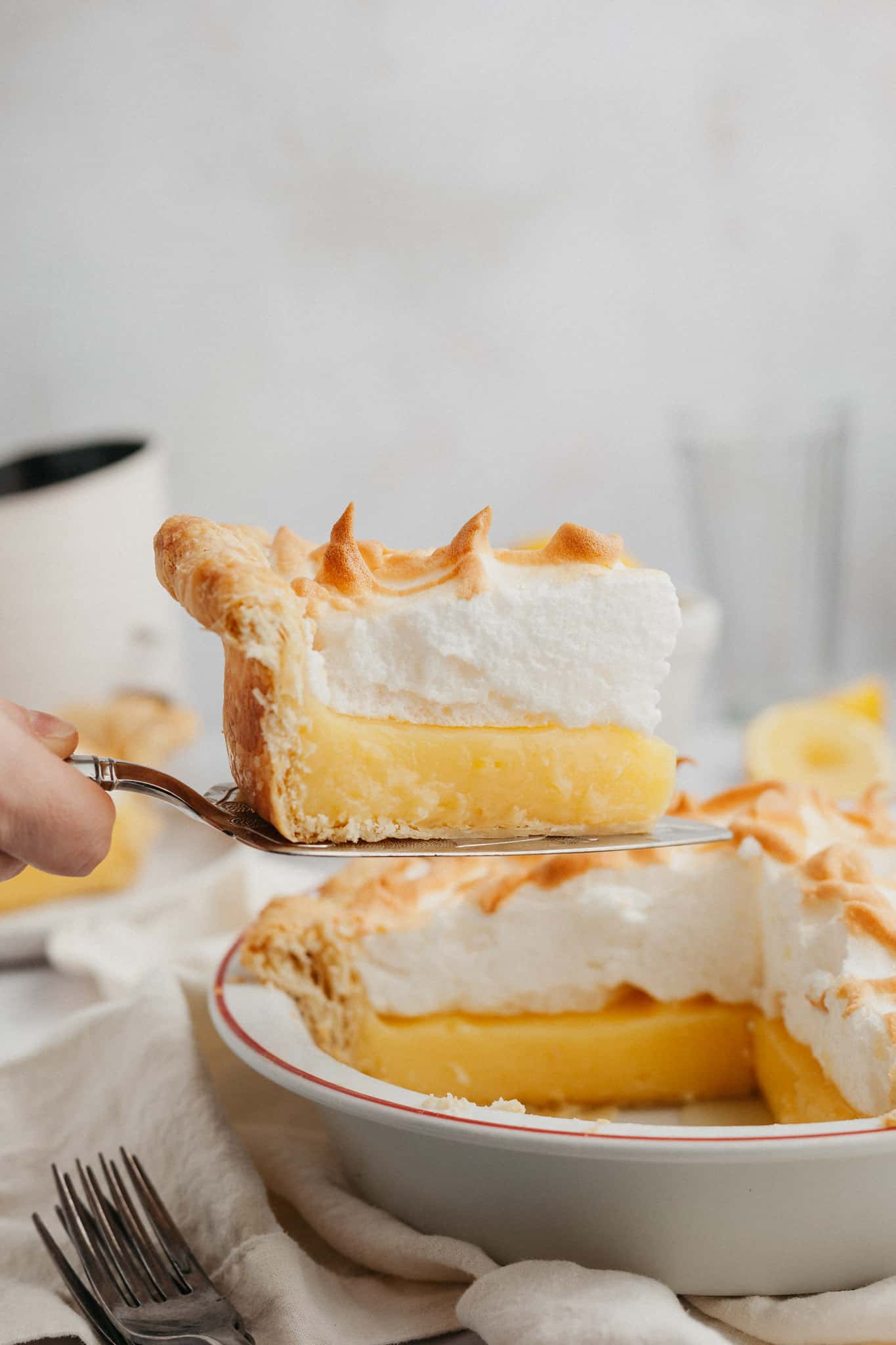
Want to Save This Recipe?
Enter your email & I'll send it to your inbox. Plus, get great new recipes from me every week!
By submitting this form, you consent to receive emails
Do you love making lemon curd? I am absolutely loving making it right now, it is so wonderfully tart and bright! If you love making lemon meringue pie, then you should check out my lemon curd cookies or my lemon bars with graham cracker crust.
Jump to:
Tell me about this recipe!
- This is a more hands on recipe, so make sure that you read the recipe through and have everything weighed out before you start baking!
- Start off with blind baking an all butter pie dough.The lemon filling doesn't need a lot of baking time so you'll want to bake the bottom and side of the pie crust first.
- Make a creamy lemon curd filling with egg yolks, cornstarch, water, sugar and butter. Once it has thickened you can pour it into your pie crust.
- While the filling is still hot, make your Italian meringue. Start off by whisking your egg whites (with a bit of cream of tartar for extra support!) until you have a soft peak meringue, then pour over a boiling sugar syrup. Italian meringue is much more stable than other meringues.
- Bake the pie to allow the meringue to become nice and toasty! Then let the pie chill completely and place in the fridge to firm up.
Ingredients Needed
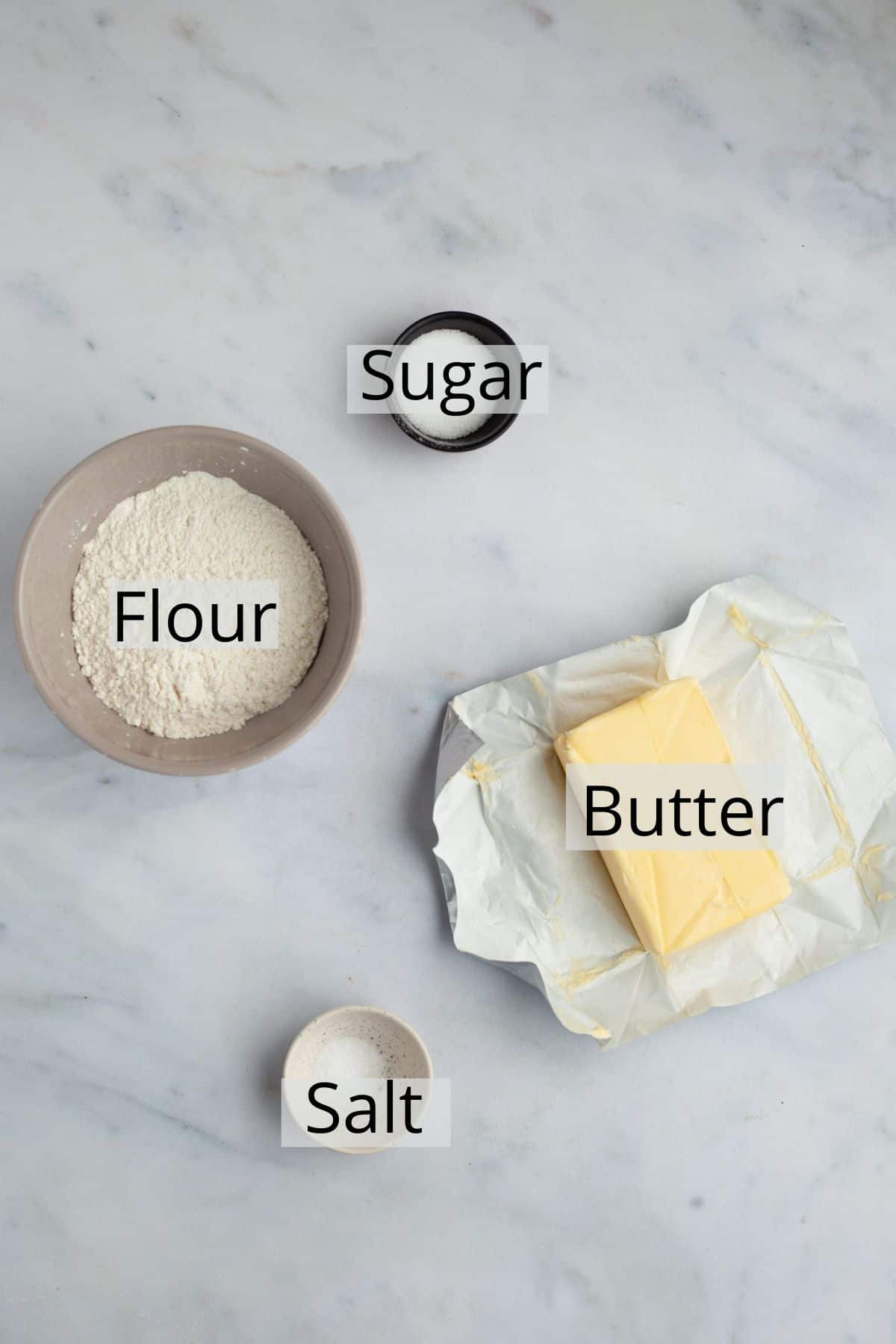
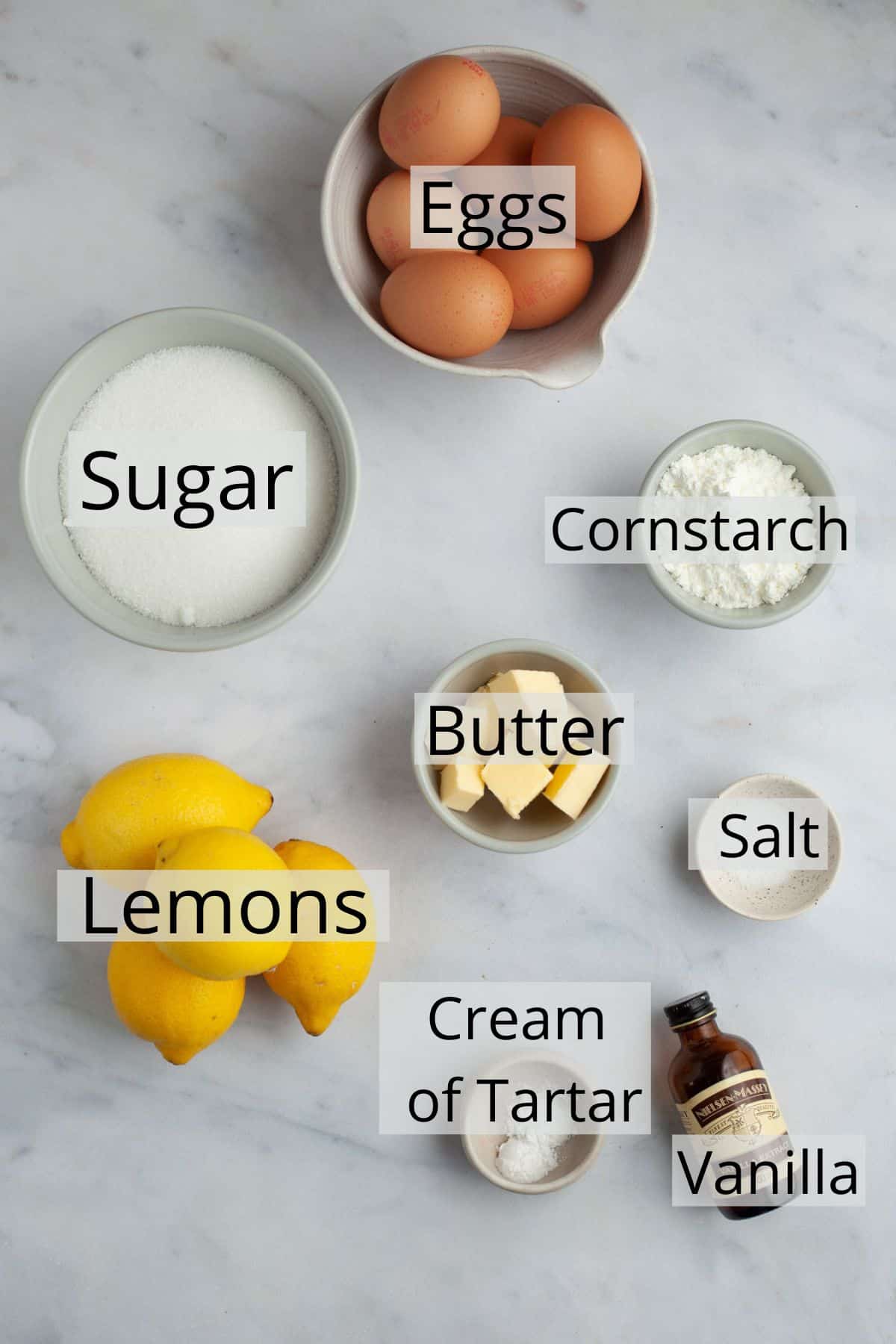
- Butter: because this is an all butter pie crust, use the best butter you can! I use European style butter, like Kerry Gold, as it has a higher butterfat content.
- Flour: I'm using all purpose flour in my pie dough.
- Cornstarch: This is what helps thicken our lemon curd filling. It is also known as cornflour in Europe.
- Cream of tartar: This helps stabilise the meringue! That way the meringue topping doesn't weep or start to breakdown.
- Eggs: We're going to need a lot of eggs for this lemon curd filling and meringue topping! When you're making the lemon curd, save the egg whites to use for the meringue.
How to make this recipe
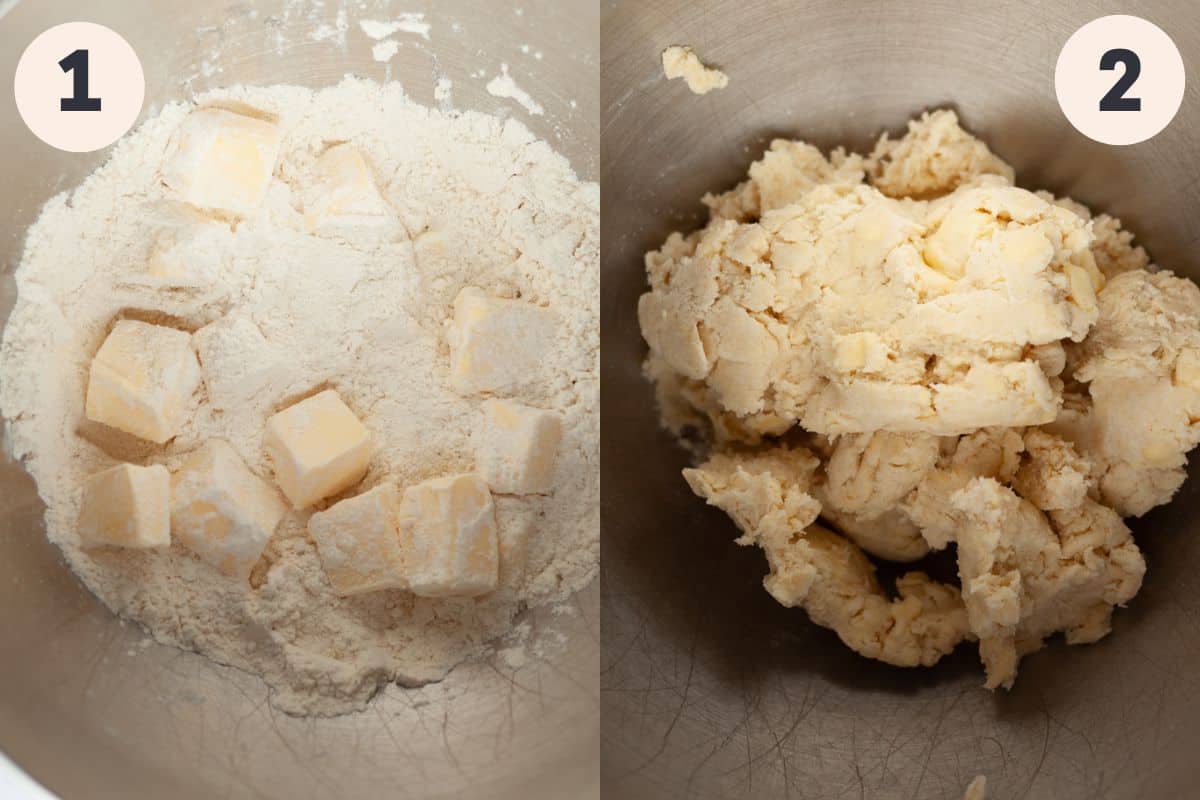
Step 1: Take half of your butter and cut into cubes. Cut the other half into thin slices and place in the fridge. Toss the cubed butter with your flour, sugar and salt. Make sure the cubes are completely covered in flour. Use your fingers to smoosh/flatten the butter, tossing through the flour and flattening until the butter is about the size of a pea.
Step 2: Add in your chilled sliced butter and toss them in the mixture, flattening them further with your fingers. You'll now have a mixture of pea sized butter chunks and these thinner slices of butter, all covered in flour. Drizzle over 5 tablespoons of ice water and toss the mixture to get everything evenly moistened. Toss until it becomes a shaggy mass. Knead it a little bit, then take out any large clumps and place on a piece of plastic wrap. Drizzle a bit more water into the bowl to moisten the leftover floury bits. Toss and lightly knead, then take out the remaining dough (once everything is just moistened, but you don't want it to be wet!) and place with the rest of the pie dough on the plastic wrap.
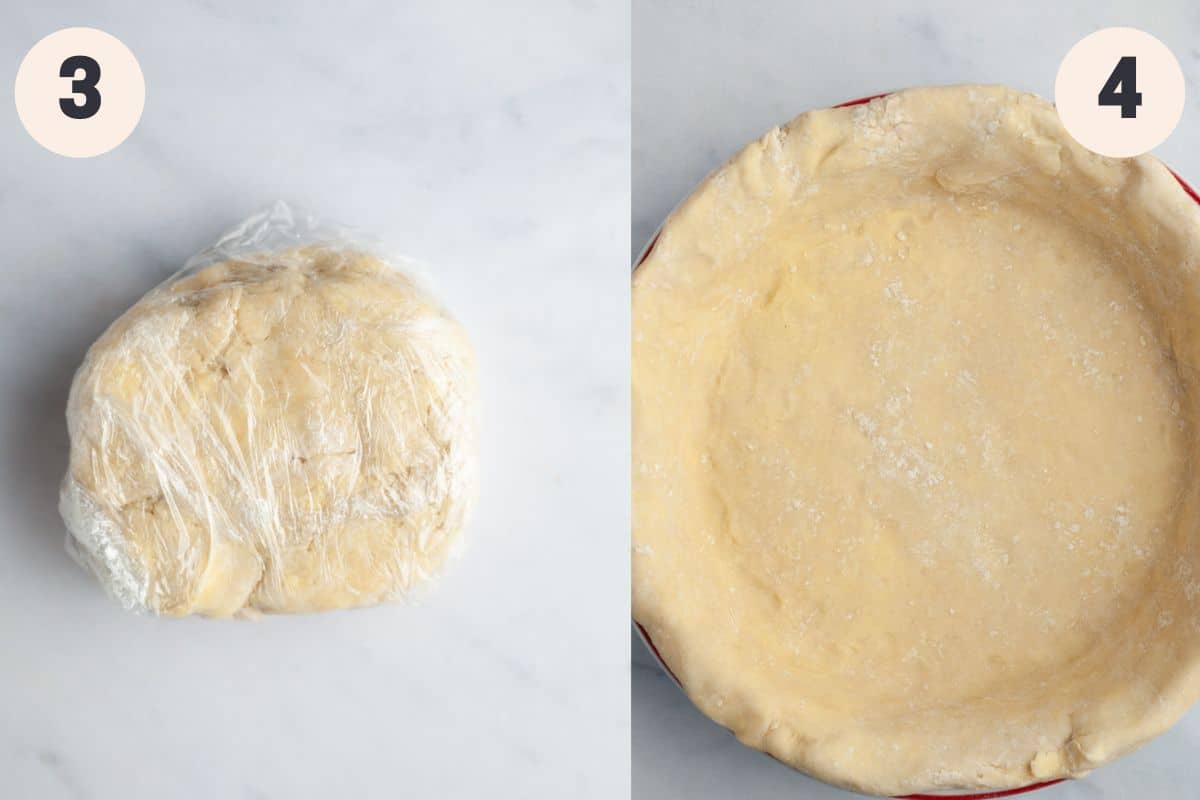
Step 3: Wrap up the pie dough tightly in the plastic wrap and form into a disc. Chill in the fridge for at least 2 hours. You can take the dough out and roll it out into a large rectangle. Then fold it into thirds (like an envelope) and wrap in plastic, chilling for another 30 minutes. This is going to make your pie dough flakier but it is optional!
Step 4: With an oven rack in the middle position, preheat your oven to to 425. Roll out your pie dough on a lightly floured surface until it is about 1.5 inches larger than your pie plate (note, I used a deep dish pie plate). Carefully place it into your pie plate and press on the bottom and along the sides of the pie plate - this is going to help your pie crust 'stick' to the plate better and not slump. Tuck the overhanging dough under and press into the pie plate. Crimp the edges as desired! Crimping is not only pretty, but it helps your crust stick to the plate better.
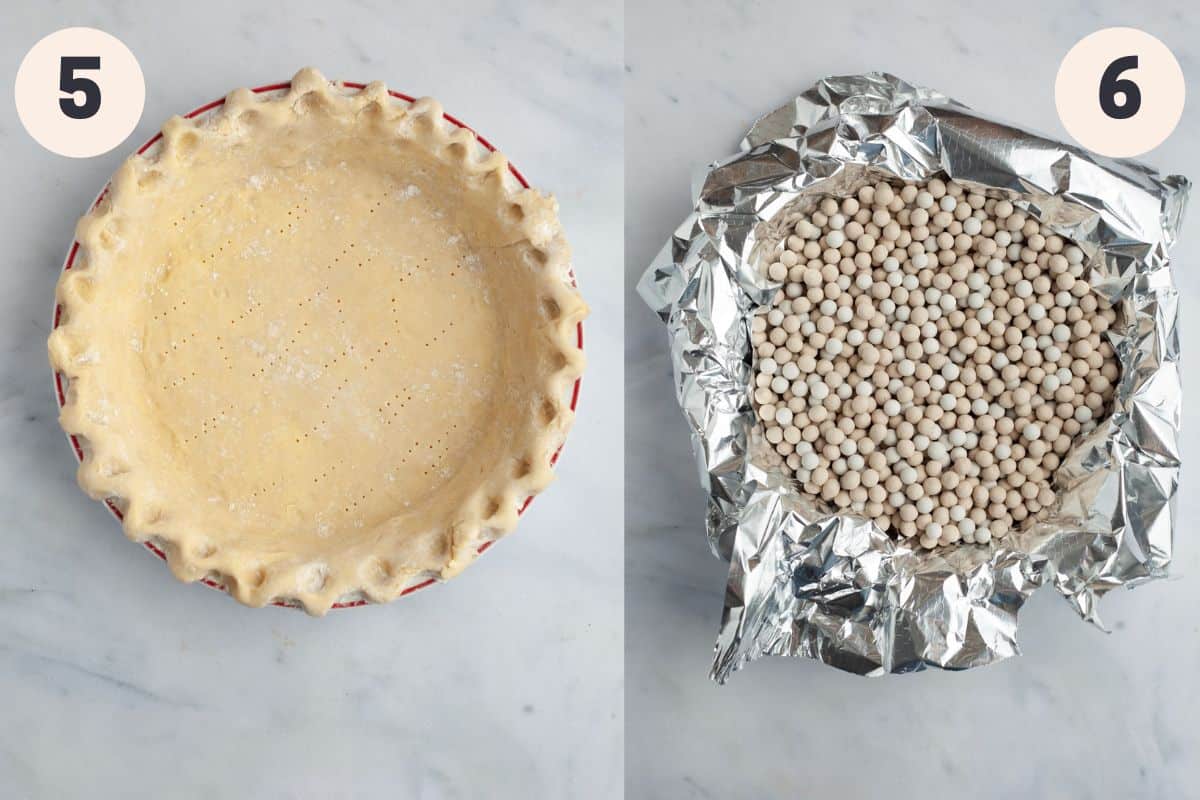
Step 5: Once your pie has been crimped, place in the freezer for 10 minutes. Note, make sure your pie plate can go from freezer to oven! Some may shatter. Once it is out of the freezer, quickly use a fork to prick the bottom and sides. This is going to help the crust not puff up too much in the oven.
Step 6: Place two pieces of foil into your pie, make sure it touches the bottom and sides. You want the two pieces of foil to make an X. Pour in your ceramic pie weighs, dry beans, rice or sugar. You can these pie weights to go all the way to the top! Bake for 15-20 minutes, then quickly remove the pie from the oven and lift the foil out. Reduce the temperature to 350 and place the pie back in to bake for another 10-12 minutes. You should have a golden brown bottom and crust. Use a pastry brush to brush an egg wash (whisk an egg yolk with a little bit of water and salt) on the bottom - this is going to help your pie not get soggy!
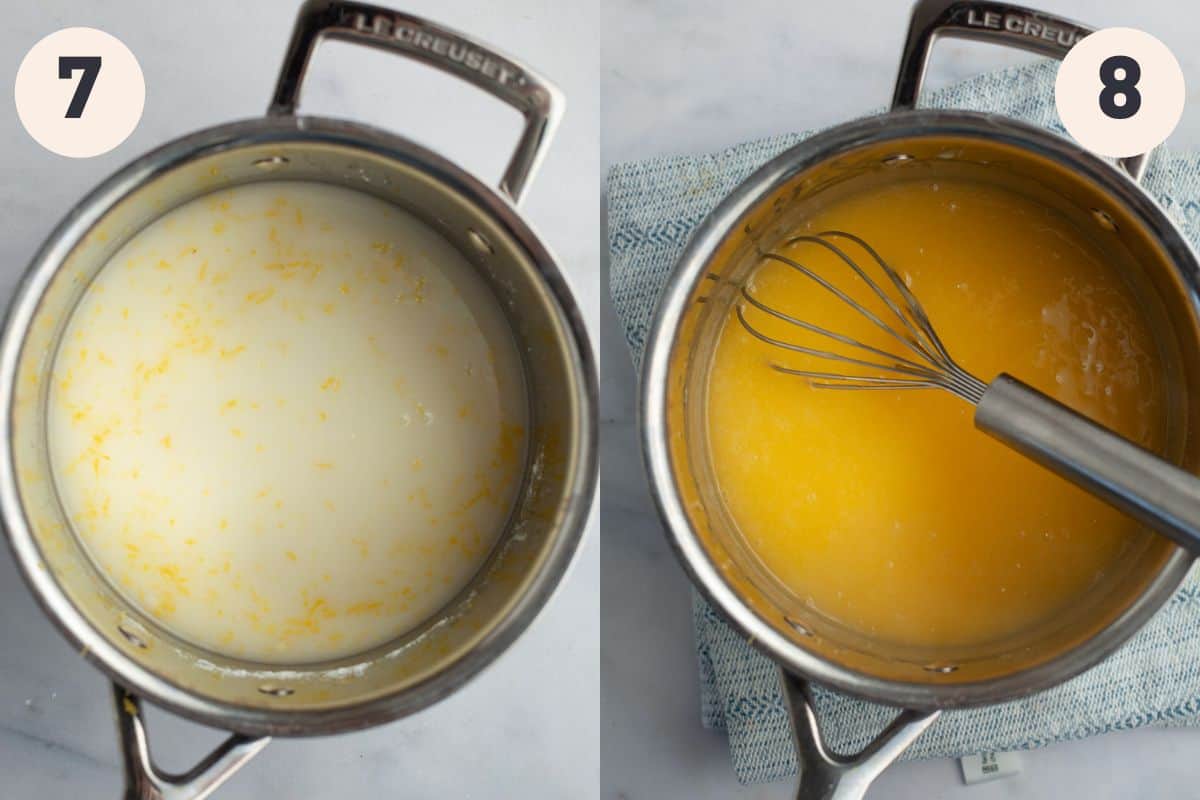
Step 7: Time to make your lemon curd! Preheat the oven to 375. Separate your eggs, leaving the whites to the side for your meringue later. Pour the yolks into a jug and whisk. In a medium saucepan, whisk the cornstarch, salt, sugar, lemon juice, lemon zest and water together. Place over medium heat and whisk constantly until it begins to thick and bubble. This takes around 4-5 minutes.
Step 8: Take the pan off of the heat and scoop out about 1 cup of this hot lemon mixture. Slowly pour it into your egg yolks while vigorously whisking the yolks - this is tempering the eggs so you don't end up with scrambled eggs! Pour the egg yolk mixture into the saucepan with the rest of the lemon mixture and whisk over low heat. Whisk until it becomes very thick and glossy, another 4-5 minutes.
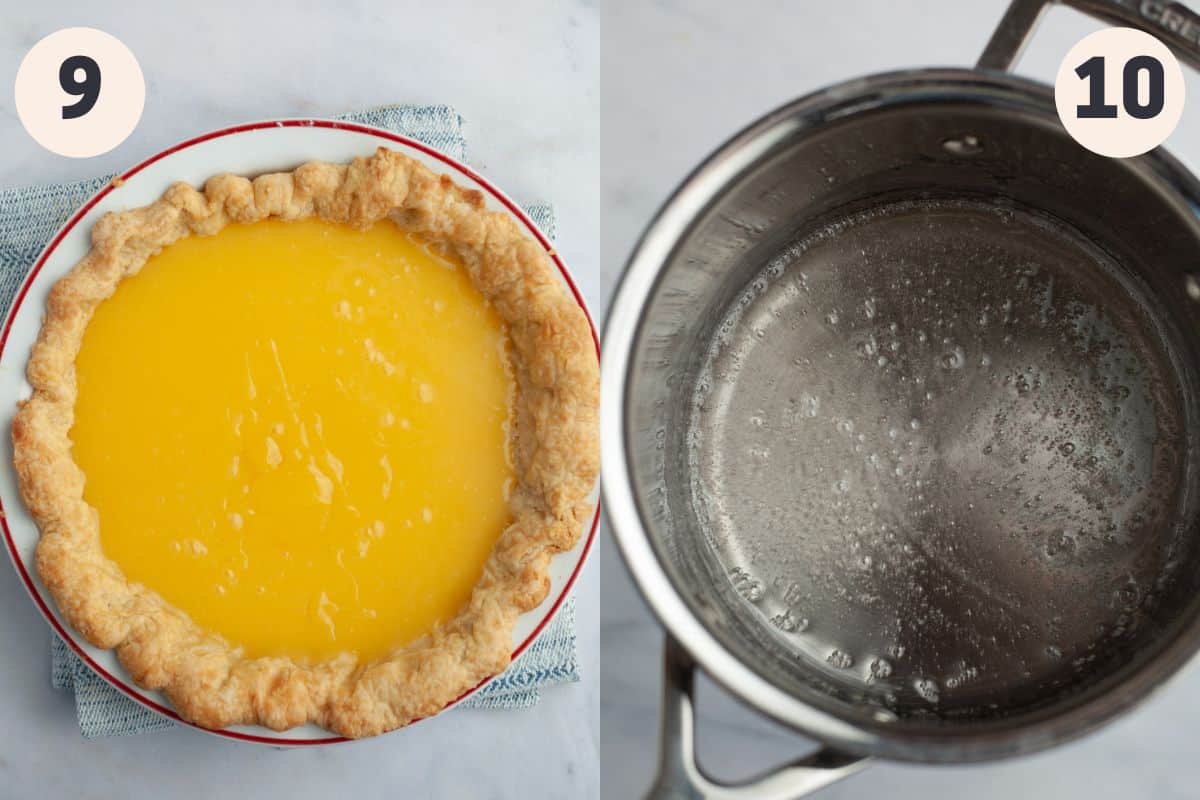
Step 9: Take the lemon filling off of the heat and whisk in your pieces of butter until they have melted. Pour the lemon curd into your cooled pie crust. Place a piece of plastic wrap on top of the lemon filling to stop it from forming a skin.
Step 10: Time to make the Italian meringue! Place your egg whites and cream of tartar in a very clean stand mixing bowl, fitted with the whisk attachment. Place your sugar and water in a small saucepan and place over medium heat until the sugar has dissolved and it begins to bubble. Lower your heat to the lowest setting.
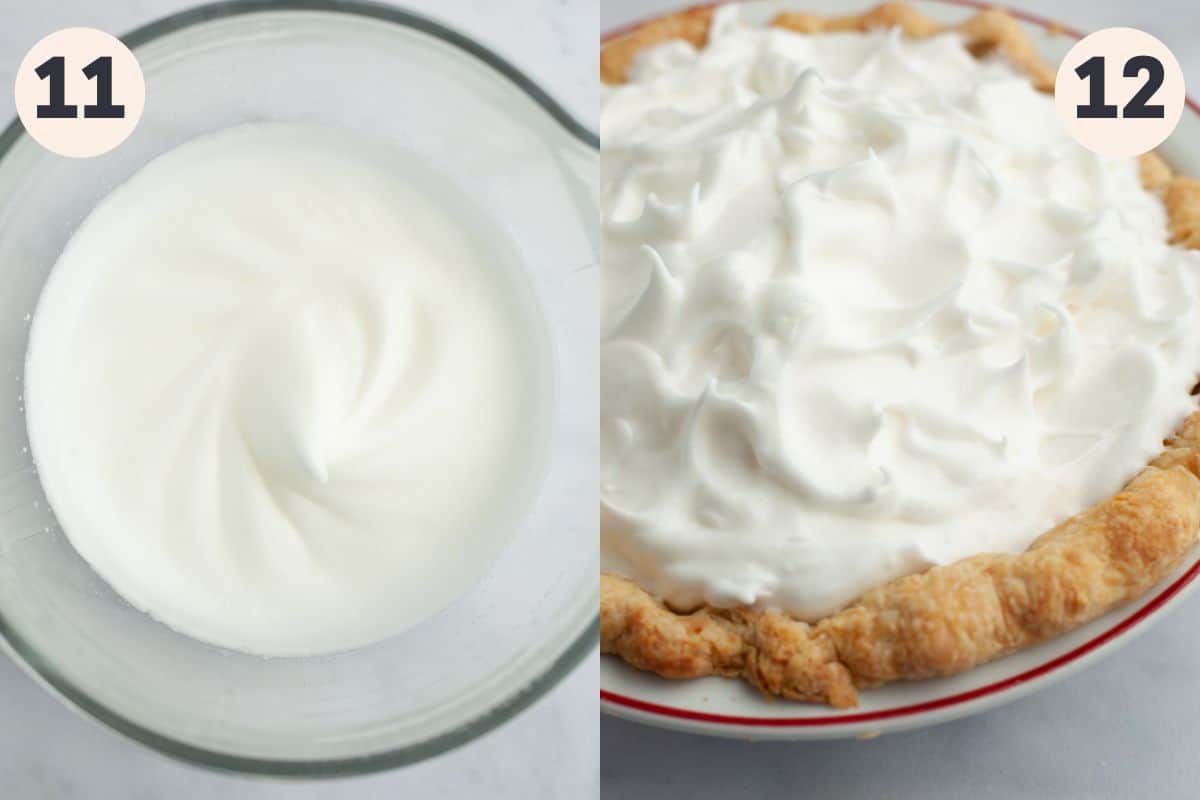
Step 11: Whisk the egg whites and cream of tartar on medium-high speed until soft peaks form. Stop the mixer and go back to your saucepan. Place a candy thermometer (or instant read thermometer) into the boiling sugar and increase the heat. Cook until it reaches 236 Fahrenheit/113 Celsius then take off the heat. Pour a small amount of this on to your meringue, then beat on high speed for 5 seconds. Stop the mixer and pour about a third of your syrup, then beat again on high for 5 seconds. Do this twice more. Beat on medium speed for 2 minutes then add your vanilla.
Step 12: Take the plastic wrap off of the lemon curd and spoon over your meringue topping. You want the meringue to be touching the pie crust, otherwise it might shrink in the oven. Use the back of a spoon to create swoops and swirls. Bake for 8-10 minutes until it is golden brown. Take it out of the oven and allow it to cool, then place in the fridge for 3-4 hours.
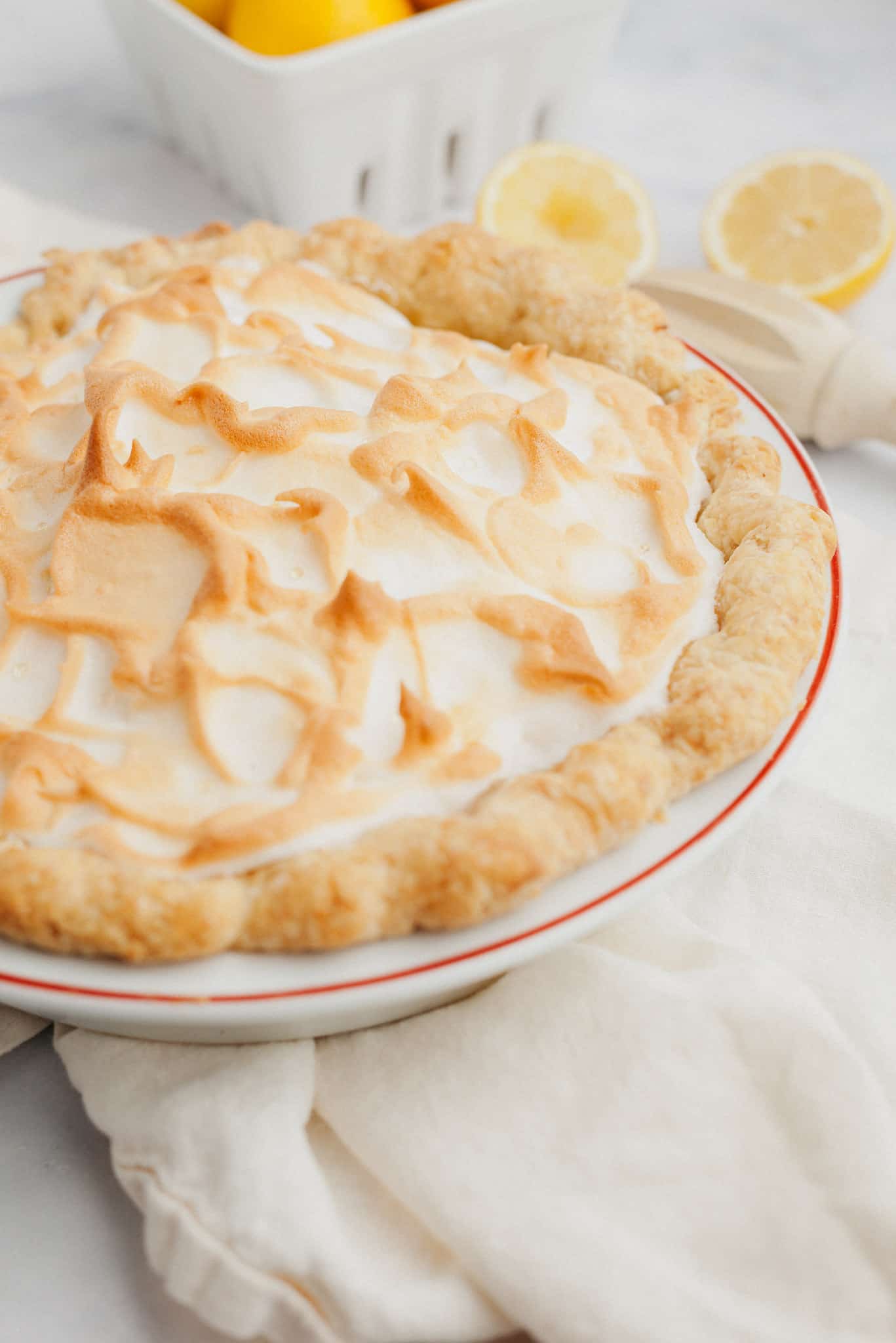
Recipe Tips & Tricks
- I recommend using a weighing scale and measuring out your ingredients the metric way. It makes a huge difference to your baking and is the most accurate way to bake!
- Make sure all of the ingredients are at room temperature for your lemon filling and meringue before you start baking. Pull out the eggs and butter 1-2 hours before you start the recipe. You want the butter for your pie though to be completely cold.
- Be sure to wash your lemons before your grate them for the lemon zest.
- Separate the eggs while they're still cold as it will be easier! You don't want any egg yolks in the egg whites as that will stop the meringue from forming.
- Try to top the pie with the meringue while the filling is still hot.
Frequently Asked Questions
You'll need to let the pie completely cool and then refrigerate for at least 3 hours. If you cut it too soon then the filling won't have set and it will ooze out.
Yes! Refrigerate before slicing, and you should refrigerate any leftovers. You can create a little tent with aluminium foil over the meringue to stop it from weeping and creating sugar beads.
There's a few reasons why your pie might be watery. You might not have weighed out the ingredients correctly for the filling, you might not have cooked the curd long enough over the stove, you might not have covered the filling with meringue while the filling was still hot, or you might not have let it chill enough in the fridge. I promise though that even a watery pie will be delicious!
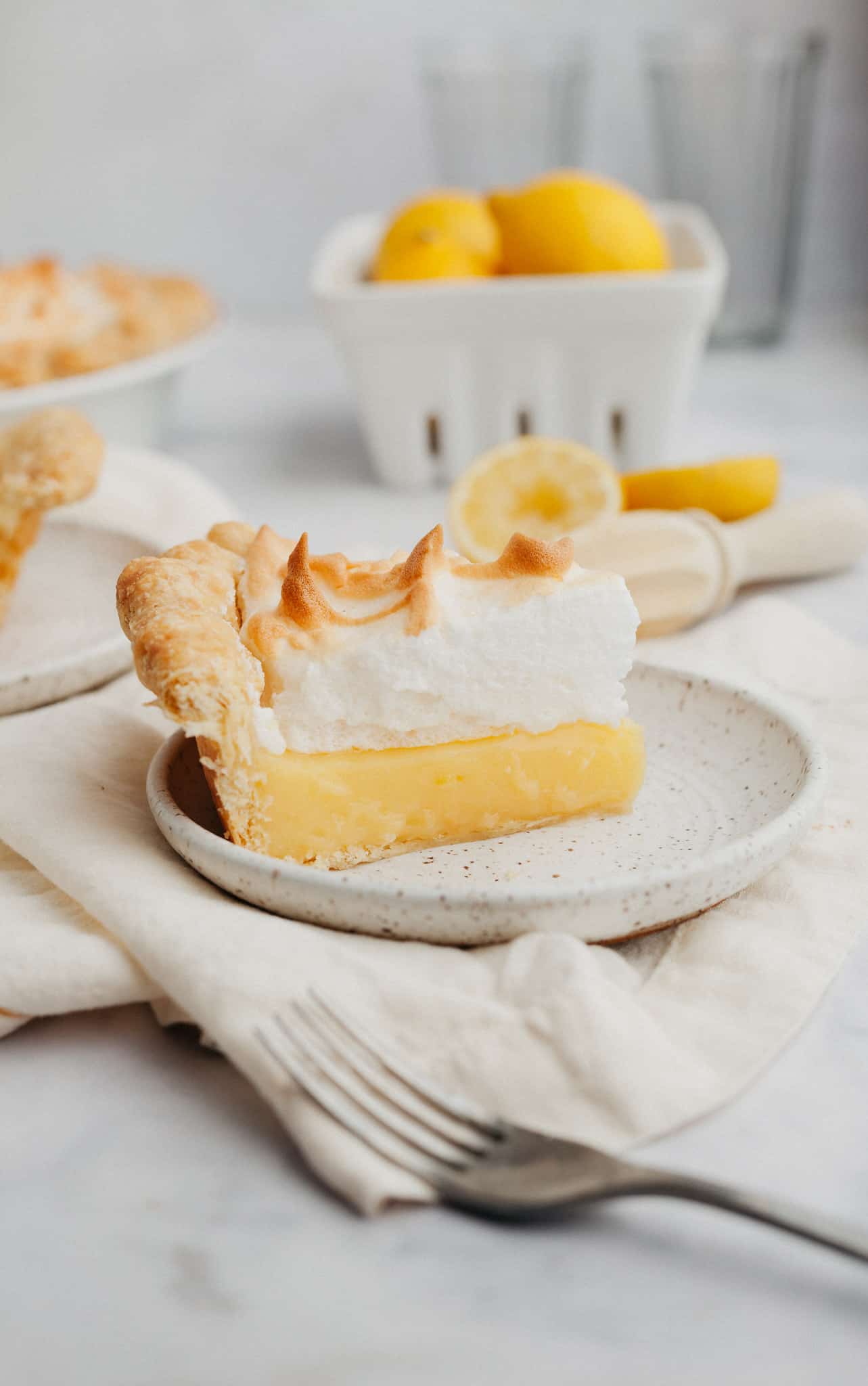
Try these lemon recipes next!
Have you made this recipe? Make sure to tag me on Instagram @alpineella and leave a review below if you have! If you want more baking ideas, you can follow me on Pinterest.
Recipe

Lemon Meringue Pie
Equipment
- 9 inch deep dish pie plate
Ingredients
All Butter Pie Crust
- 200 grams all purpose flour
- ½ teaspoon kosher salt
- 140 grams unsalted butter cold
- 1 tablespoon sugar
Lemon Filling
- 300 grams sugar
- 6 egg yolks room temperature
- 57 grams unsalted butter room temperature
- 45 grams cornstarch
- 1 teaspoon kosher salt
- 1 tablespoon lemon zest
- 120 ml lemon juice
- 360 ml water
Italian Meringue
- 99 grams sugar
- 4 egg whites room temperature
- 2 tablespoons water
- pinch kosher salt
- ½ teaspoon cream of tartar
- 1 teaspoon vanilla extract
Instructions
Make Pie Crust
- Fill a measuring jug with water and ice, place in the fridge. Take out a piece of plastic wrap and place it near where you are working.
- Take half of your butter and cut into thin slices, about ⅛ inch thick and then place in the fridge.
- In a large bowl, whisk together the flour, salt and sugar.
- Take the remaining butter and cut into ½ inch cubes. Toss the cubes of butter in the dry ingredients, making sure they’re all evenly coated. Use your fingers to smoosh the butter into the flour, you want to completely flatten the cubes and make them smaller until the biggest pieces of butter are about the size of a pea.
- Take out the chilled butter slices and add them to the bowl, tossing to coat in the flour, then use your fingers to flatten the butter slices. You’ll now have a mixture of very small and slightly larger bits of butter.
- Drizzle 5 tablespoons of your ice water into the flour (make sure not to have any ice fall in). Use your hands to toss the flour and butter. Continue tossing the mixture until it forms a shaggy mass. Knead it just a bit, and take out any large clumps of dough and place on to the plastic wrap. Continue drizzling ice water, a tablespoon at a time, and kneading the dough until just a couple of dry spots remain and you have one large piece of dough. Place on to the plastic wrap.
- Form the dough into a disc, then wrap it tightly in the plastic wrap. Refrigerate for at least 2 hours.
- Take it out of the fridge and let it sit for about 5-10 minutes (depending how cold your kitchen is) to make it easier to roll out. Place it on a lightly floured surface and roll the dough out into a rectangle. Fold the dough in thirds, then rewrap tightly in plastic. Refrigerate for at least another 30 minutes (or up to 2 days)
- With an oven rack in the middle position, preheat your oven to 425°F/220°C.
- Take the dough out of the fridge and let it come to room temperature for 5-10 minutes. Roll the dough out on a lightly floured surface until it is about an inch wider than your pie plate. I find it easiest to gently lift the dough and place it on to the plate, but you can also roll it up on to your rolling pin and then unroll it on to your pie plate.
- Let the dough slump into the plate and press very firmly on to the bottom and the area where the side and the bottom of the pie plate meet - this is going to help it not slump when baking!
- Tuck the overhang underneath, this is going to give you a thicker edge. Go back and use your hand and fingers to firmly press your dough into the pie plate. Crimp the edges as desired, crimping firmly into the pie plate is going to help it not shrink and hold its shape.
- Place your pie plate in the freezer for 10 minutes. Take the pie out and use a fork to prick the bottom a few times - this will make the bottom not puff up as much when baking.
- Line the inside of the pie dough with two pieces of foil, making an X shape, and be sure you have the foil hanging over the edges - this will make it easier to lift out after baking. You also want the overhanging foil to cover the crust so it doesn’t brown too much.
- Fill the pie plate with your pie weights, dried beans or sugar. Bake on the middle shelf of your oven for 15-20 minutes. The edges should be a light golden colour. Quickly take the pie out and lift the foil and pie weights out. Reduce the temperature of the oven to 350°F/175°C and place the pie back in. Bake for another 10-12 minutes until golden brown. Remove from the oven and let cool completely.
- Use a pastry brush to wash an egg wash (whisk an egg yolk with a splash of water and a pinch of salt) at the bottom of the pie, this will help seal the crust.
Make Lemon Filling
- Preheat your oven to 375°F/190°C. Place your prebaked pie crust and place on a baking sheet.
- In a jug, whisk together your egg yolks and then set aside. Keep your whites for your meringue.
- In a medium nonreactive saucepan, whisk your cornstarch, sugar, salt, lemon zest, lemon juice, and water together. Place over medium heat and cook, whisking, until it begins to thicken and bubble. This will take about 4-5 minutes.
- Take the pan off the heat and pour about 1 cup of the hot lemon mixture into your yolks, whisking the yolks vigorously so they don’t start to curdle. Pour this warm egg mixture back into your pan and place it over a low heat. Whisk constantly until it becomes thick and glossy, about 4-5 minutes.
- Take the pan off the heat and add the butter, a piece at a time, whisking until it has completely melted.
- Pour the filling into your cooled pie crust. Place a piece of plastic wrap on to the surface. Note, the curd is going to thicken a lot more because it is going to get cooked and then cools - so don’t worry if it isn’t as thick as you thought it would be!
Make Italian Meringue
- Place your egg whites and cream of tartar into an incredibly clean stand mixer bowl and set to the side. Fit your stand mixer with the whisk attachment. You want to make sure there are no bits of egg yolk in the egg whites left, the egg yolk contains fat which will stop a meringue from forming.
- In a small saucepan, stir your sugar and water together. Place it over medium heat, stirring constantly, until your sugar dissolves and it begins to bubble. Decrease the heat to your lowest setting.
- Go to your mixer and beat the egg whites on medium-high speed until medium-soft peaks form. Stop the mixer. You don't want the peaks to be super stiff and pointing straight up, instead they should have a soft bend at the tip.
- Go back to your saucepan and increase the heat, place a candy thermometer or instant read thermometer into the mixer and boil the syrup until it reaches 236°F/113°C degrees. Take it off the heat and pour the syrup into a glass measuring jug to stop the cooking process
- Pour a small amount of this sugar syrup on your egg whites, then beat on high speed for 5 seconds. Stop the mixer and pour about a third of your syrup, then beat again on high for 5 seconds. Do this twice more. Beat on medium speed for 2 minutes, then add in your vanilla and pinch of salt and whisk once more.
- Take the plastic wrap off your lemon filling and use a small offset spatula to cover the filling. Make sure your meringue topping is touching the crust all the way around the pie - this helps the meringue not to shrink. Use the back of a small spoon to create swoops and swirls.
- Bake for 8-10 minutes at 375°F. The meringue should be golden brown. Remove it from the oven and let it cool for at least 1 hour, then place in the fridge for 3-4 hours before serving.
- This is best eaten on the same day. To keep for another day, refrigerate it and tent the pie with foil



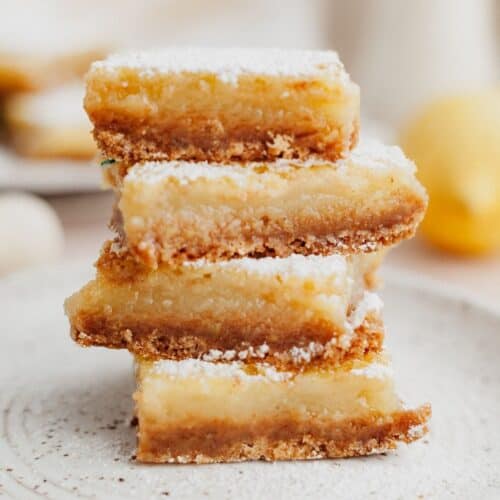

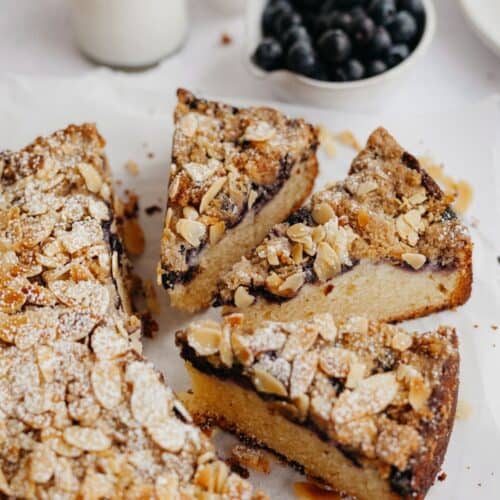
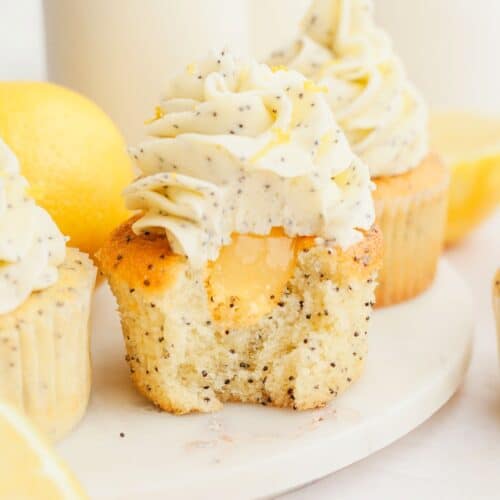
Leave a Reply